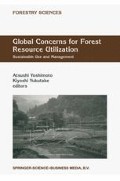Abstract
In Japan and the United States, people are placing greater emphasis on green (non-timber) resources. In independent studies designed to elicit social preferences for forest functions in Japan and in the United States, survey respondents were asked to rank their preferences for two sets of forest functions and to choose between two functions in a series of paired choices. Japanese respondents indicated that land and water conservation, wildlife conservation, scenic beauty, in that order, were more important than timber production. Their preferences for specific land and water conservation measures varied by local disaster history. In paired comparisons, they weighted land and water conservation, wildlife, scenic beauty, and timber functions in decreasing order of preference. United States respondents indicated that air and water quality was the most important issue and that timber and forest products supply was second in importance. However, in paired comparisons, timber was the least important function. These respondents also indicated a willingness-to-pay approximately 32 US$ per year to protect the full range of forest functions by means of conservation easements. Respondents in each country indicated clear preferences for non-timber forest values. The extent to which forest managers respond to these preferences will impact the flows of forest goods and services. Cultural differences will affect the means by which public agencies in Japan and the United States assess and incorporate public sentiment into forest management. Private forestry will be affected through the differing objectives of landowners and regulatory climates. These, too, have important cultural aspects. Research cooperation and information exchanges across the Pacific may provide new insights for solving resource management issues.
Access this chapter
Tax calculation will be finalised at checkout
Purchases are for personal use only
Preview
Unable to display preview. Download preview PDF.
References
Cooksey, R.A. Jr. 1994. Conservation easements as a public good: The willingness to pay for forest land benefits protected with conservation easements in the northern forest lands, New Hampshire. M.S. Thesis. University of New Hampshire, Durham. 140 p.
Echelberger, H.E., Luloff, A.E., and Schmidt, F.E. 1991. Northern forest lands: Resident attitudes and resource use. USDA Forest Service. Northeastern Experiment Station. Research Paper. RP-NE-653.
Environment Agency. 1989. Aspects of nature: National survey on the natural environment, japan. Kasumigaseki, Tokyo, Japan. 18 p.
Forest Stewardship Council. 1998. http://www.fscusne.org/draft/index.htm
Helms, J. A. 1998. Silviculture: Past, present, and future. Journal of Forestry 98 (7): 1.
Inoue, M., and Ishibashi, S. 1994. The historical change of forest use in Japan. P. 90–99 in
Proceedings of the IUFRO International Workshop on Sustainable Forest Management. October 17–21, 1994. Furano, Hokkaido, Japan.
Japan FAO Association. 1994. Forests and forestry in Japan. Japan FAO Association, Tokyo. 65 p.
MacCleary, D.W. 1994. American forests: A history of resiliency and recovery. Forest History Society, Durham, North Carolina. 58 p.
Saaty, T.L., and Alexander, J.M. 1989. Conflict resolution: The analytic hierarchy approach. Praeger. New York. 252 p.
Shigematsu, T. 1991. Conservation and management of suburban forests by the citizens. Shinzansha, Tokyo, ‘74p. (in Japanese).
Sugimura, K. 1993. Evaluation of forest functions by local people: Development of a research method. P. 555–566 in Proceedings, Advancement in Forest Inventory and Forest Management Sciences, IUFRO Conference, Seoul, Korea, Sept 20–25, 1993.
Takeda, M., Ogawa, S., and Inoue, S. 1997. A questionnaire investigation on erosion control works among neighboring residents. Bulletin of the Ehime University Forest. 35: 55–76. College of Agriculture, Ehime University, Matsuyama, Japan.
Tokoro, M. 1980. Studies on the forestry history in the rrecent times. Kobunkan, Tokyo, 858 p. (in Japanese).
Totman, C. 1983. From exploitation to plantation forestry in early modern Japan. P. 270–283 in Steen, H. K., ed., History of Sustained Yield Forestry: A Symposium. Western Forestry Center, Portland, OR. Oct. 18–19. Forest History Society and the International Union of Forestry Research Organizations, 270–283.
Williams, M. 1989. Americans and Their Forests: A Historical Geography. Cambridge University Press, New York. 599 p.
Editor information
Editors and Affiliations
Rights and permissions
Copyright information
© 1999 Springer Science+Business Media Dordrecht
About this chapter
Cite this chapter
Howard, T.E., Sugimura, K., Cooksey, R.A. (1999). Emerging Human Values of Forest Resources. In: Yoshimoto, A., Yukutake, K. (eds) Global Concerns for Forest Resource Utilization. Forestry Sciences, vol 62. Springer, Dordrecht. https://doi.org/10.1007/978-94-017-6397-4_12
Download citation
DOI: https://doi.org/10.1007/978-94-017-6397-4_12
Publisher Name: Springer, Dordrecht
Print ISBN: 978-90-481-5320-6
Online ISBN: 978-94-017-6397-4
eBook Packages: Springer Book Archive

